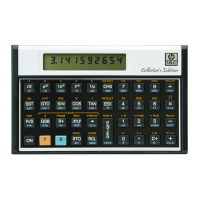192 Section 13: Finding the Roots of an Equation
Many functions exhibit special behavior when their arguments
approach zero. You can check your function to determine values of
x for which any argument within your function becomes zero, and
then specify estimates at or near those values.
Although two different initial estimates are usually supplied when using
_, you can also use _ with the same estimate in both the X-
and Y-registers. If the two estimates are identical, a second estimate is
generated internally. If your single estimate is nonzero, the second
estimate differs from your estimate by one count in the seventh
significant digit. If your estimate is zero, 1 × 10
−7
is used as the second
estimate. Then the root-finding procedure continues as it normally would
with two estimates.
Using _ in a Program
You can use the _ operation as part of a program. Be sure that the
program provides initial estimates in the X- and Y-registers just prior to
the _ operation. The _ routine stops with a value of x in the
X-register and the corresponding function value in the Z-register. If the x-
value is a root, the program proceeds to the next line. If the x-value is not
a root, the next line is skipped. (Refer also to Interpreting Results on page
226 for a further explanation of roots.) Essentially, the _
instruction tests whether the x-value is a root and then proceeds
according to the “Do if True” rule. The program can then handle the case
of not finding a root, such as by choosing new initial estimates or changing
a function parameter.
The use of _ as an instruction in a program utilizes one of the seven
pending returns in the calculator. Since the subroutine called by _
utilizes another return, there can be only five other pending returns.
Executed from the keyboard, on the other hand, _ itself does not
utilize one of the pending returns, so that six pending returns are
available for subroutines within the subroutine called by _.
Remember that if all seven pending returns have been utilized, a call to
another subroutine will result in a display of
Error 5
. (Refer to page 105.)

